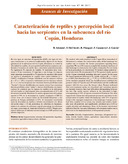Mostrar el registro sencillo del ítem
Caracterización de reptiles y percepción local hacia las serpientes en la subcuenca del río Copán, Honduras
| dc.contributor.author | DeClerck, Fabrice A. J. | es Es |
| dc.creator | Alemán, Bayardo | es_Es |
| dc.creator | Finegan, Bryan | es_Es |
| dc.creator | Casanoves, Fernando | es_Es |
| dc.date.accessioned | 2015-03-19T21:03:00Z | |
| dc.date.available | 2015-03-19T21:03:00Z | |
| dc.date.issued | 2011 | |
| dc.identifier | 487894 | es_ES |
| dc.identifier.issn | 1022-7482 | es_ES |
| dc.identifier.uri | https://repositorio.catie.ac.cr/handle/11554/5867 | |
| dc.description.abstract | En tres tipos de sistemas silvopastoriles (SSP), dos tipos de bosques remanentes y en potreros tradicionales, típicos de las fincas ganaderas de la subcuenca del río Copán, Honduras, se evaluó la diversidad de reptiles y la percepción local hacia las serpientes utilizando el transecto de ancho fijo y entrevistas semiestructuradas. Se registraron 56 especies de reptiles: 34 serpientes (seis venenosas y 28 no venenosas), 21 lagartijas y una tortuga. La riqueza total esperada correspondió a 78 especies. Se encontró diferencia en riqueza y abundancia de reptiles entre cuatro hábitats (p = 0,0001), resultando el bosque latifoliado con los mayores valores (s = 15, n = 109) y el potrero tradicional con los menores valores (s = 2, n = 4). Las serpientes no venenosas fueron percibidas como “buenas” y fueron identificadas con menor certeza. Las venenosas fueron percibidas como “malas” y fueron identificadas con mayor certeza. Se concluyó que la riqueza de reptiles en la subcuenca del río Copán es relativamente alta, correspondiendo al 24% del inventario actual de Honduras. La matriz agropecuaria del paisaje aportó el 70% de la diversidad de reptiles, resaltando el SSP de cercas vivas con el mayor índice de diversidad (Shannon), y los parches de bosque latifoliado el 30%. Se determinó correlación entre la diversidad de reptiles y árboles con diámetro a la altura del pecho (dap) < 10 cm, porcentaje de cobertura de hojarasca, número de estratos de cobertura vegetal, porcentaje de cobertura de copa y porcentaje de humedad relativa (p 5,383 0,05). Ningún productor indicó que el ofidismo sea desventaja en el SSP-potrero con árboles dispersos. | es_ES |
| dc.description.abstract | We worked with cattle ranchers in the Copan River watershed of Honduras to evaluate the conservation value of this landscape for reptiles and to evaluate the farmer perceptions regarding these organisms. We used 48 transects, sampled the dominant landuses of this landscape to characterize the reptile community. For our study of local perceptions, we interviewed 56 farmers using semi-structured interviews. We documented 56 of 78 expected reptile species in the Copan watershed, including nine new reports for the area. We found significant differences for reptile richness (F5,383 = 6.69 y p = 0.0001) and abundance (F5,383 = 7.20 y p = 0.0001) between four of the landuses sampled, where the broadleaf forest exhibited the greatest values (15 species and 109 individuals) and the traditional pasture with low tree cover the lowest values. Farmers indicated that non-venomous snakes are beneficial, and venomous species are harmful, however they had difficulties distinguishing between the two. The reptile species richness in the watershed is high, corresponding to 24% of species recorded in Honduras. Our data supports the notion that silvopastoral systems do contribute to the conservation of reptiles within this landscape with 70% of species found in the managed component of the landscape. Canopy cover, leaf litter, number of tree strata, tree density, and relative humidity were all positively and significantly correlated (p 5,383 0.05) to reptile diversity and abundance. None of the farmers interviewed indicated that the increased abundance of venomous snakes was a deterrent to the implementation of silvopastoral systems. | en_EN |
| dc.format.mimetype | ||
| dc.language.iso | es | es_ES |
| dc.publisher | CATIE, Turrialba (Costa Rica) | es_ES |
| dc.relation.ispartof | Agroforestería en las Américas, número 48 (2011) | |
| dc.rights.uri | https://creativecommons.org/licenses/by-nc-nd/4.0/ | |
| dc.subject | CULEBRA | es_ES |
| dc.subject | LAGARTO | es_ES |
| dc.subject | TORTUGAS TERRESTRES | es_ES |
| dc.subject | REPTILES | es_ES |
| dc.subject | EXPLOTACIONES GANADERAS | es_ES |
| dc.subject | POTREROS | es_ES |
| dc.subject | BOSQUE REMANENTE | es_ES |
| dc.subject | CUENCAS HIDROGRAFICAS | es_ES |
| dc.subject | RIO COPAN | es_ES |
| dc.subject | HONDURAS | es_ES |
| dc.title | Caracterización de reptiles y percepción local hacia las serpientes en la subcuenca del río Copán, Honduras | es_ES |
| dc.type | Artículo | es_ES |
| dc.journal.issueNumber | 48 | |
| dc.journal.pages | 103-117 |



